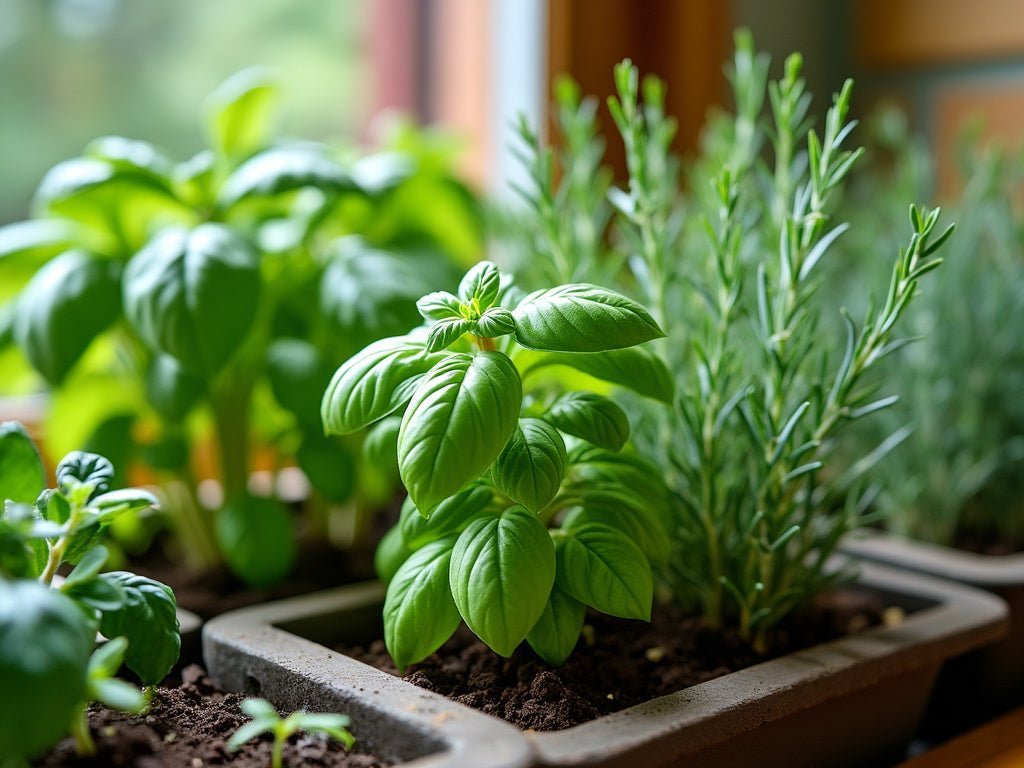
From Seed to Harvest: The Ultimate Guide to Growing Vibrant Herbs Indoors & Out (+ Expert Tips)
|
|
Time to read 4 min
|
|
Time to read 4 min
Table of contents
There's something magical about snipping fresh basil for your homemade pizza or steeping a cup of mint tea from leaves you've grown yourself. Herb gardening isn't just a hobby; it's a journey into self-sufficiency and culinary creativity.
Whether you're a seasoned gardener or a curious beginner, herb gardening offers rewards that go beyond the plate. Let's explore how you can start your own herb garden, no matter where you live.
Living in an apartment or dealing with a long winter? No problem! Indoor herb gardens are the perfect solution.
Herbs love light. Place your indoor garden near a south-facing window for optimal sunlight. If natural light is scarce, consider using grow lights to give your herbs the energy they need.
Select containers with good drainage to prevent waterlogged roots. A mix of potting soil, perlite, and compost creates an ideal growing medium for most herbs.
Want to keep your herbs organized? Check out these Wooden Plant Labels for just $14.99. They're perfect for identifying your herbs and add a rustic charm to your indoor garden.
Herbs prefer to be on the drier side. Water when the top inch of soil feels dry, and ensure good air circulation to prevent fungal issues.
Got a bit more space? Let's take your herb garden outdoors!
Most herbs thrive in full sun. Choose a location that gets at least 6 hours of direct sunlight daily.
Well-draining soil is key. Mix in compost to improve soil structure and provide nutrients. Learn more about soil preparation.
Give your herbs room to grow. Space them according to their mature size to prevent overcrowding.
Elevate your outdoor herb garden with these Bohemian Bliss Macrame Plant Hangers. At $29.99 for a set of 5, they're a stylish way to display your herbs and save space.
The moment you've been waiting for - it's time to enjoy your herbs!
Cut herbs in the morning after the dew has dried but before the heat of the day. This ensures the best flavor and longevity.
Fresh herbs can be stored in the fridge, dried, or frozen. Each method has its benefits for preserving flavor.
Experiment with your fresh herbs in cooking. From pesto to herbal teas, the possibilities are endless. Discover new recipes and uses for your herbs.
Even the most experienced gardeners face challenges. Here's how to tackle common herb gardening problems:
Use natural methods like neem oil or companion planting to keep pests at bay.
Proper spacing and air circulation are your best defenses against fungal diseases.
Ready to take your herb gardening to the next level?
Some herbs grow better together. Basil and tomatoes are classic companions that enhance each other's growth and flavor.
Limited on space? Go vertical! Use wall-mounted planters or tiered shelves to maximize your growing area.
Create a magical ambiance in your vertical herb garden with these Solar String Lights for $39.99. They're perfect for illuminating your herbs and creating a cozy outdoor space.






Q: How often should I water my herbs?
A: It depends on the herb and environment, but generally, water when the top inch of soil feels dry.
Q: Can I grow herbs year-round indoors?
A: Yes! With proper lighting and care, many herbs can thrive indoors all year.
Q: What are the easiest herbs to grow for beginners?
A: Basil, mint, and chives are great starter herbs that are forgiving and versatile.
Herb gardening is a rewarding journey that connects you with nature and enhances your culinary adventures. Whether you're snipping fresh basil from your windowsill or harvesting rosemary from your garden, the satisfaction of growing your own herbs is unmatched.
Ready to start your herb garden? Remember, the key to success is in the details - proper light, water, and care. With a little patience and love, you'll be enjoying fresh herbs in no time. Happy gardening!